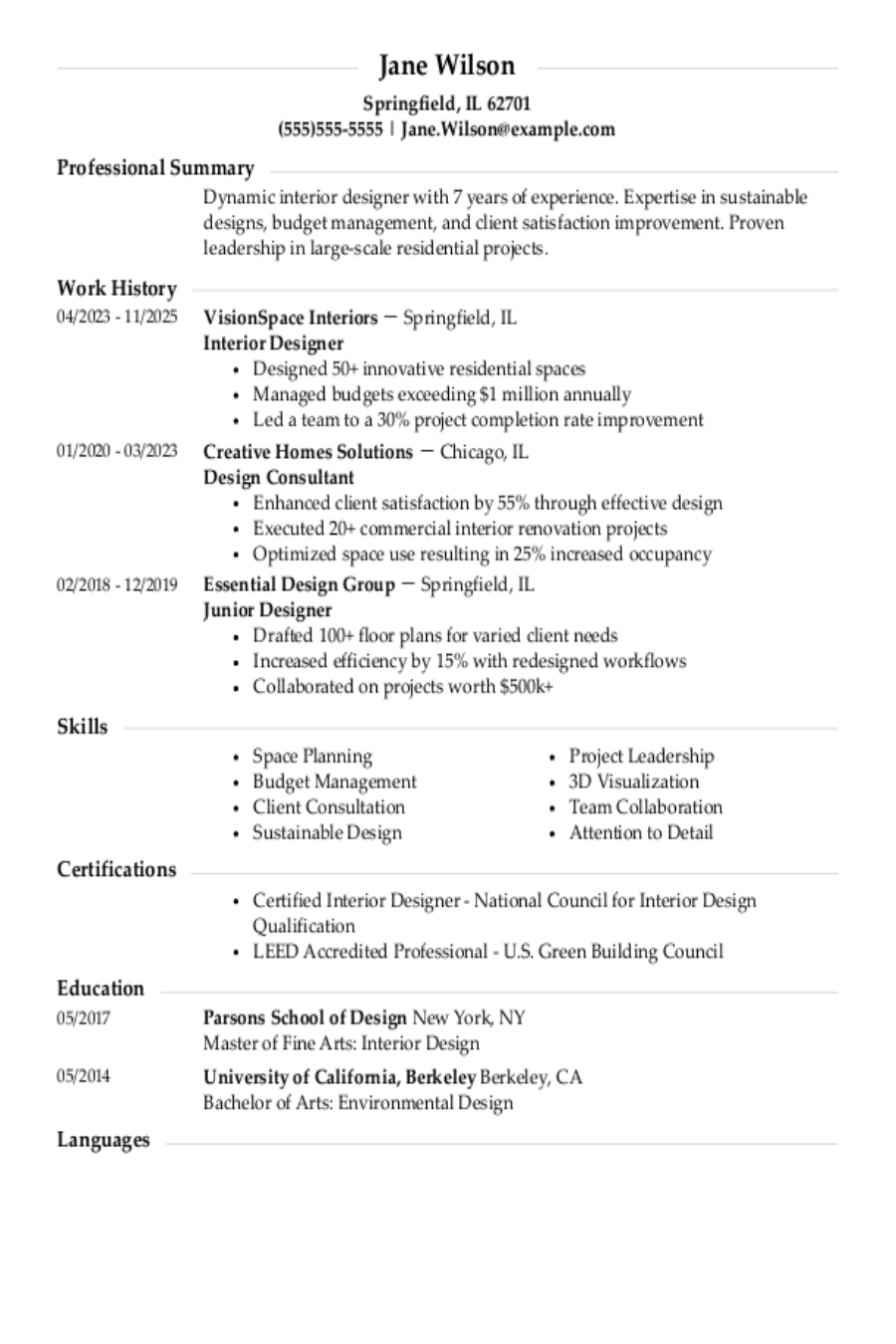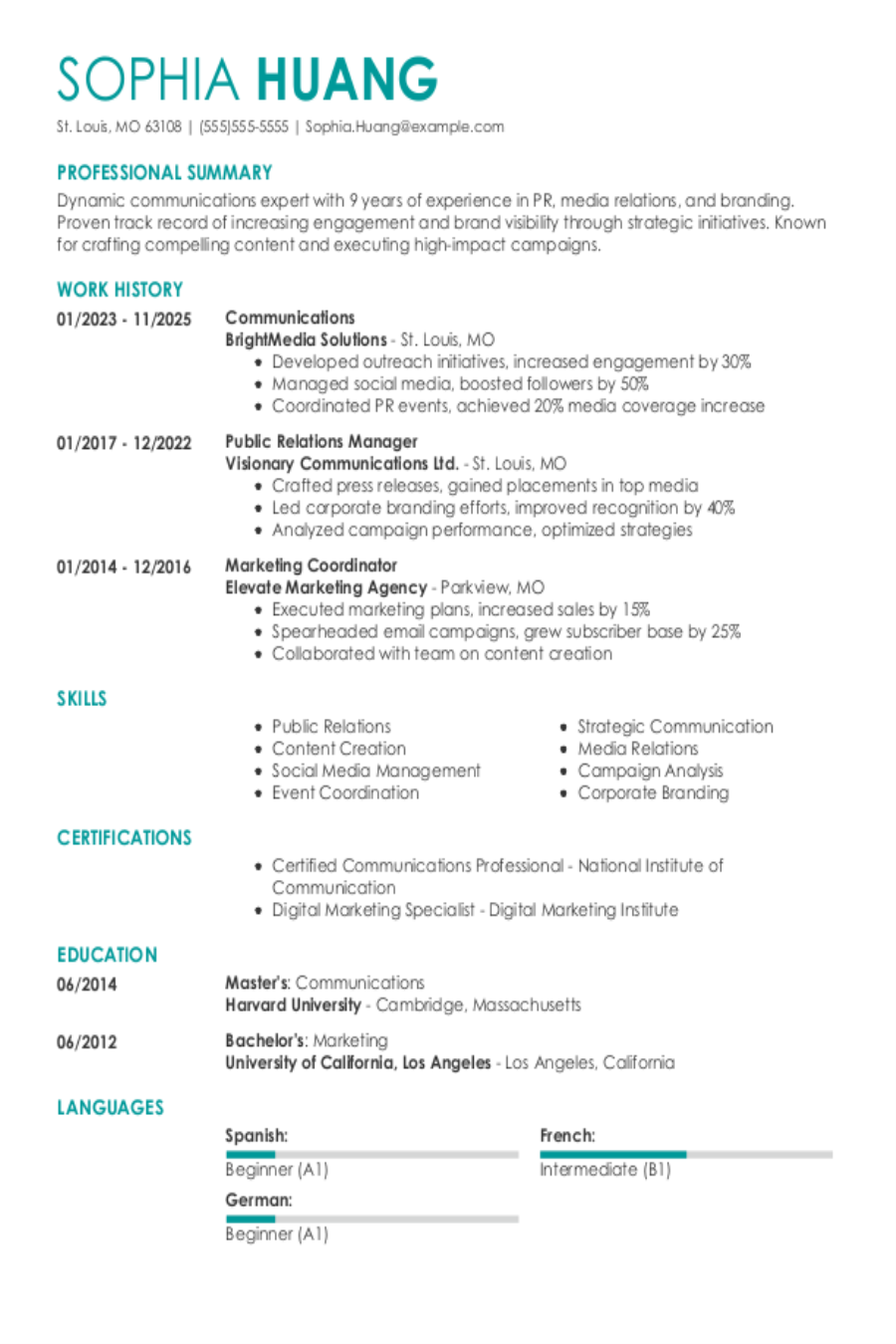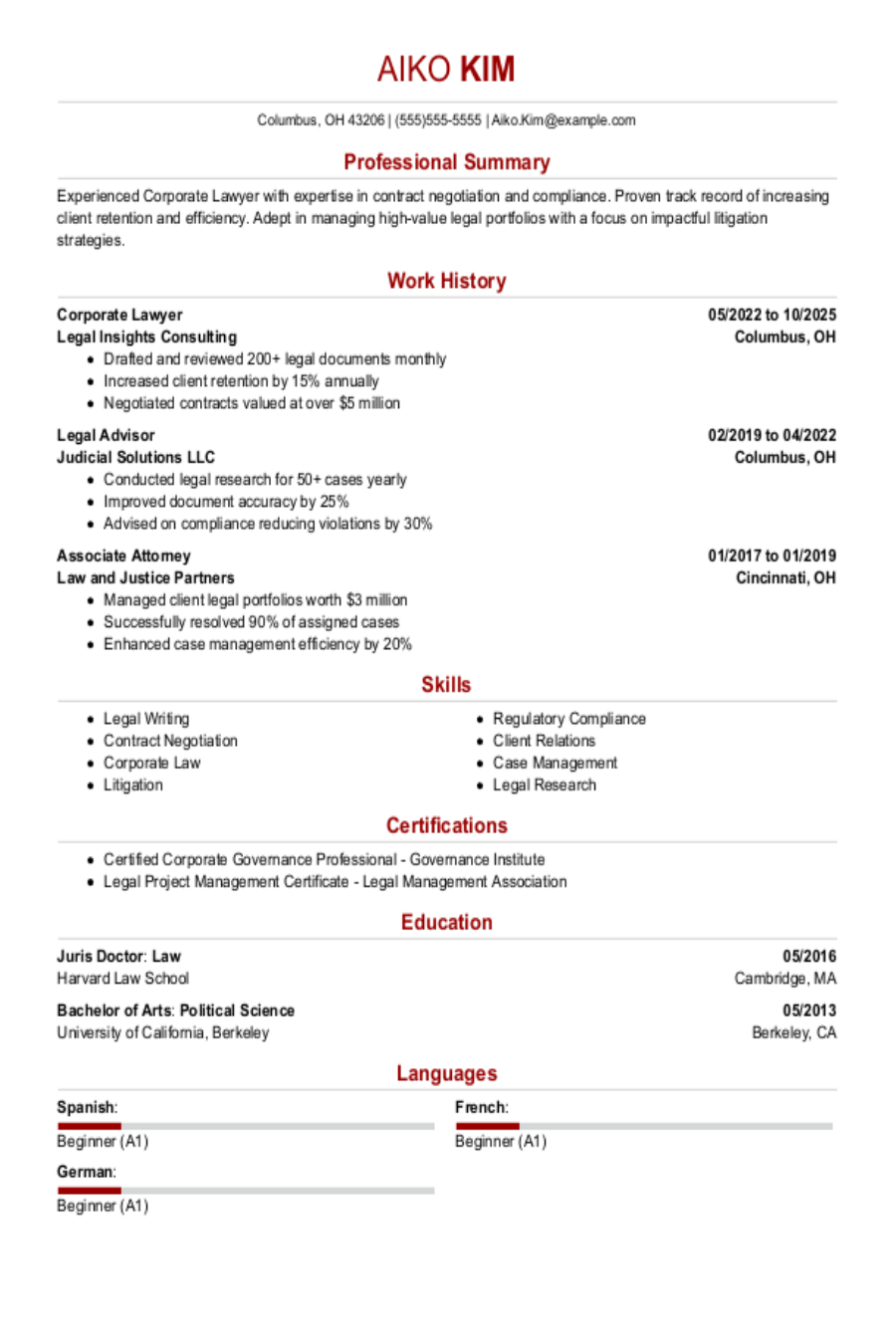Popular Food Service Resume Examples
Entry-level food service resume
An entry-level resume for food service should focus on customer service skills, teamwork, relevant certifications, and any volunteer experience to show a strong work ethic and passion for the industry.
Prioritizes readability: Choosing a simple resume template allows job seekers to present their qualifications clearly and efficiently. This simplicity helps recruiters quickly grasp essential information about the applicant's skills and experience.
Showcases education: This resume strengthens the candidate’s credibility by prominently displaying their educational qualifications.
Mid-career food service resume
A mid-career food service resume should emphasize a combination of hands-on experience, customer service skills, and continuous professional development to attract attention from potential employers.
Balances skills and experience: This experienced job seeker's resume effectively showcases a mix of technical skills in inventory management and customer service, alongside clear career progression from catering assistant to food service leader, highlighting professional growth.
Employs active language: Words like "reduced," "trained," and "implemented" are action verbs that highlight significant contributions to efficiency and team development, showcasing a proactive approach in food service roles.
Experienced food service resume
An experienced food service resume should prioritize highlighting relevant skills and achievements that demonstrate the job seeker's growth and contributions to the industry.
Quantifies achievements: Quantifiable achievements, such as a 20% improvement in service speed or a 30% reduction in inventory waste, make accomplishments clear and effective for recruiters. These metrics provide a tangible measure of success that stands out on a resume.
Highlights experience: The resume opens with a compelling summary that showcases the applicant's 13 years of experience in food service. This immediately establishes credibility and sets a professional tone, highlighting skills in improving service speed and customer satisfaction.
No experience food service resume
A resume for an applicant with no experience applying for a food service position should focus on relevant skills, volunteer work, and customer service experiences that demonstrate their potential and enthusiasm for the role.
Emphasizes professional skills: Emphasizing professional skills in food service highlights the job seeker's ability to handle various tasks and contribute effectively, even with limited direct experience in the industry.
Avoids jargon: Job seekers often feel pressured to embellish their experience with elaborate terms or descriptions for straightforward tasks. However, this resume's clear and honest presentation of responsibilities, like assisting in meal distributions and organizing events, makes a stronger impact.
More resume examples
Food Service Resume Template
Looking to create a standout application? Use this food service resume template as your foundation—easily personalize it with your own details and experiences.
Olivia Johnson
Springfield, IL 62706
(555)555-5555
Olivia.Johnson@example.com
Professional Summary
Dynamic Food Service Specialist with 9 years' expertise in the hospitality industry. Proven record in enhancing customer service and sales performance. Skilled team leader proficient in menu development and event planning.
Work History
Catering Manager
The Urban Fork - Springfield, IL
May 2022 - Current
- Increased customer satisfaction by 20%
- Managed daily sales of $3,000+ efficiently
- Trained 5 new staff members monthly
Hospitality Associate
Harborview Bistro - Springfield, IL
January 2017 - April 2022
- Boosted repeat customers by 30% through service
- Handled inventory to reduce wastage by 15%
- Organized events increasing revenue by $10K
Culinary Service Aide
Maple Leaf Dining - Springfield, IL
January 2014 - December 2016
- Streamlined kitchen operations by 25%
- Implemented new menu boosting sales $5K+
- Executed cost-saving measures for $2K yearly
Skills
- Customer Service
- Team Leadership
- Sales Management
- Inventory Control
- Menu Development
- Event Planning
- Cost Efficiency
- Food Safety
Certifications
- Certified Food Service Manager - National Restaurant Association
- Event Planning Professional - International Event Management Institute
Education
Master's Degree Hospitality Management
University of Washington Seattle, Washington
June 2013
Bachelor's Degree Culinary Arts
Washington State University Pullman, Washington
June 2011
Languages
- Spanish - Beginner (A1)
- French - Beginner (A1)
- Mandarin - Beginner (A1)
Writing Your Food Service Resume
Having explored these effective resume examples, you are now prepared to dive into the detailed process of how to write a resume. We will guide you step by step, covering each section to ensure your resume stands out.
List your most relevant skills
An effective skills section on your food service resume should highlight both your culinary abilities and interpersonal skills. You want to ensure that you showcase relevant keywords from the job listing, such as food safety, customer service, and teamwork. This not only demonstrates your qualifications to human recruiters but also increases your chances of passing through applicant tracking systems.
By emphasizing keywords from the job listing, you’re making it clear that you understand what is required and are ready to contribute effectively in a food service environment.
Example of skills on a food service resume
- Proficient in managing food preparation and safety protocols to ensure high standards
- Skilled in providing excellent customer service and resolving issues efficiently
- Team-oriented with a positive attitude, fostering a collaborative work environment
- Detail-focused with strong organizational skills for inventory management
A well-structured skills section is critical in demonstrating your readiness for a food service role. It should incorporate both the technical skills specified in the job description and essential soft skills, highlighting your ability to effectively manage responsibilities and interact positively with customers and team members. This comprehensive approach showcases your preparedness to meet the demands of the position.
Highlight your work history
Your work experience section is your opportunity to emphasize achievements and the skills you’ve applied in various situations to help set yourself apart from other job seekers.
For each job entry, ensure you include key details like your title, the name of the establishment where you worked, and the dates of employment. This information provides employers with a clear timeline of your professional background, allowing them to gauge your experience effectively.
Example of a food service work experience entry
- Food Service
Café Gourmet - San Francisco, CA
June 2021 - Present - Prepare and serve an average of 300+ meals daily while adhering to food safety standards and maintaining a clean work environment
- Deliver outstanding customer service by promptly addressing orders, handling inquiries, and ensuring guest satisfaction with a 98% feedback score
- Collaborate with kitchen staff to optimize workflow and improve menu offerings based on seasonal ingredients, resulting in a 15% increase in customer return rate
- Train 3 new team members on food preparation techniques and safety protocols, improving overall team efficiency by 25%
- Consistently achieved daily sales targets through effective upselling strategies and promoting daily specials, boosting revenue by 10%
Highlighting outcomes and achievements in your experience section is essential as it showcases your contributions to the food service industry. Employers are more drawn to applicants who can demonstrate how they improved efficiency, improved customer satisfaction, or increased sales, rather than just listing daily tasks. This results-oriented approach clearly illustrates your value and sets you apart from other applicants.
Include your education
The education section of your food service resume should present your qualifications in reverse-chronological order starting with your most recent degree or certification. Include any relevant diplomas and exclude your high school diploma if you hold higher-level qualifications.
For those currently pursuing a degree or involved in ongoing education, it's important to list the highest level achieved so far along with the expected graduation date. Including bullet points that highlight relevant coursework or significant projects can be helpful for students or recent graduates looking to showcase their learning experiences.
Common certifications for a food service resume
- ServSafe Food Manager Certification – National Restaurant Association
- Certified Food Protection Manager (CFPM) – American National Standards Institute (ANSI)
- Food Service Management Professional (FSMP) – National Restaurant Association
- HACCP Certification – International HACCP Alliance
Sum up your resume with an introduction
Creating an effective profile section is important for your resume, as it serves as your first opportunity to make a strong impression on potential employers. This section encapsulates who you are and what you bring to the table, allowing hiring managers to quickly gauge your fit for the food service role.
If you have extensive experience in the industry, a professional summary is ideal for showcasing your key accomplishments and qualifications. This approach allows you to highlight specific skills and successful outcomes that demonstrate your value, making it easier for recruiters to see how you can contribute to their team.
If you don't yet have much experience, include a resume objective that focuses on your aspirations and development.
Professional summary example
Dynamic food service professional with over 8 years of experience in fast-paced dining environments. Demonstrated success in improving customer satisfaction through excellent service delivery and staff training. Proficient in inventory management, menu planning, and optimizing operational workflows to drive efficiency and profitability.
Resume objective example
Enthusiastic food service professional eager to apply strong communication and teamwork skills in a fast-paced dining environment. Looking to contribute to a vibrant team by ensuring excellent customer experiences and maintaining high standards of food safety and quality.
Your resume profile should always start with your job title. Whether you choose a professional summary or an objective statement, this immediate identification helps employers recognize your expertise and what you bring to the table in the food service industry.
Add unique sections to set you apart
Including optional resume sections for food service positions can highlight your unique qualifications and experiences. These additional segments allow you to present a fuller picture of who you are as a job seeker.
Consider detailing relevant hobbies, like cooking or event planning, which showcase your passion for the industry. Additionally, mentioning volunteer work at local shelters or community kitchens reflects your commitment to service and teamwork. Such information not only demonstrates your skills but also illustrates your personal values, making you a more attractive applicant in the eyes of potential employers.
Three sections perfect for a food service resume
- Languages: In food service, effective communication is essential for customer satisfaction. If you speak multiple languages, highlight those language skills on your resume to improve guest interactions and broaden your appeal to diverse clientele.
- Volunteer Work: Including volunteer work on a resume showcases your teamwork and leadership skills while highlighting your dedication to serving others. It adds depth to your professional profile and demonstrates a giving spirit.
- Accomplishments: In food service, quantifiable accomplishments are key to demonstrating your effectiveness in a fast-paced environment. Display these achievements by embedding them in your work experience or placing them in a standalone accomplishments section.
5 Resume Formatting Tips
- Choose a format that matches your career stage.
When crafting your resume, consider your experience level and the appropriate resume format. If you have a wealth of food service experience, a chronological format showcases your career progression effectively. For those just starting out, a functional resume emphasizes your skills and strengths. A combination format can also be a great way to highlight both your experience and abilities.
- Pick a smart resume template.
Using a professional resume template improves readability and helps your qualifications stand out. Choose a clean, ATS-friendly design to ensure hiring managers can easily scan your information. When opting for a custom layout, prioritize clarity and simplicity to make a lasting impression.
- Select an appropriate font.
Choose a clear, professional font like Helvetica, Georgia, or Verdana to improve the readability of your resume. These fonts are excellent choices that appeal to both ATS and recruiters alike.
- Use consistent formatting.
Ensure your resume is neatly aligned to the left and maintains uniform margins for a polished, professional look.
- Keep your resume to one or two pages.
When outlining your resume, remember that resumes should be one page long unless you have extensive experience. To capture attention effectively, keep your content concise and focused on the highlights.
What’s the Average Food Service Salary?
Food service salaries vary based on location, career level, and qualifications.
This data, provided by the Bureau of Labor Statistics, will show you expected salary ranges for food services in the top 5 highest-paying states, including the District of Columbia. The figures reflect the most current salary data available, collected in 2024.
- Full Range
- Most Common (25th–75th percentile)
- Average
Washington
Most common: $76,740 - $102,000
District of Columbia
Most common: $71,860 - $102,400
New Jersey
Most common: $70,410 - $109,160
Hawaii
Most common: $66,940 - $99,990
New York
Most common: $67,090 - $99,770
Tools for Your Job Search
Are you ready to advance in the food service industry? Before submitting your application for that coveted role, consider using our ATS Resume Checker. This tool provides essential insights into how your resume performs with the automated systems that many restaurants and hospitality companies use to screen job seekers.
To further improve your resume, try our AI Resume Builder, which offers personalized content suggestions tailored specifically to your food service experience. With professionally designed templates, it ensures your skills and achievements catch the attention of hiring managers.
Frequently Asked Questions
Last Updated: November 21, 2025
Yes, a cover letter is important as it adds depth to your resume and creates a personal connection with employers. It allows you to express what draws you to the food service industry and highlight how your skills make you an ideal job seeker. Make sure to write a cover letter that improves your application.
For a quick solution, use our AI Cover Letter Generator to craft a tailored cover letter in minutes. Choose from various cover letter template options that perfectly align with your resume, ensuring a consistent and professional presentation of your culinary journey.
A resume is a concise document typically spanning one to two pages, focusing on your skills and experience relevant to a specific job. In contrast, a CV can extend several pages and provides a comprehensive overview of your academic background, research contributions, publications, and detailed professional experiences.
You’ll want to use a CV when applying for positions in academia, scientific fields, law, or medicine. If you need to create an impressive CV quickly, our online CV Maker is here to help! Choose from various tailored CV templates designed for different industries and career levels to make the process easy and efficient.
Choosing the right resume format is important for effectively showcasing your qualifications. Inexperienced applicants often benefit from a functional format, as it highlights skills over work history. Conversely, experienced professionals should opt for a chronological format to emphasize their robust career journey. For those at mid-level positions, a combination format serves as an excellent choice, mixing both skills and experience to present a well-rounded profile. This tailored approach ensures your resume aligns with your career stage and strengths.
To make an impressive food service resume, select a clean and professional template, while incorporating relevant keywords from the job description. This strategy showcases your qualifications and aligns with employer expectations effectively.
Improve your food service career by actively pursuing certifications and training programs tailored to your interests. Engage with professional networks, subscribe to industry publications, and participate in workshops or online courses to keep your skills sharp and stay informed about evolving trends in the culinary world.
To show your commitment to continuous development in food service, consider earning relevant certifications. Document any courses you've completed, seminars you've attended, and industry books or articles you’ve read. Additionally, listening to relevant podcasts and joining professional associations can highlight your dedication to staying current with trends and best practices in the field.
Was this information helpful? Let us know!
Hailey is a career advice writer dedicated to helping job seekers excel in their careers.
More resources

Still in the Game: 9 in 10 Older Workers Are Upskilling to Stay Competitive
The idea that older workers are resistant to change doesn t ho...

The AI Boss Effect: 97% of Workers Have Asked ChatGPT for Advice Instead of Their Manager
Resume Now s latest report explores how AI is replacing manage...

37 Unique Skills to Put on Your Resume
Trying to avoid the skills you see pop up on resumes repeatedl...

Interior Design Resume: Examples, Templates & Tips for 2025
In interior design first impressions are important. Make head...



